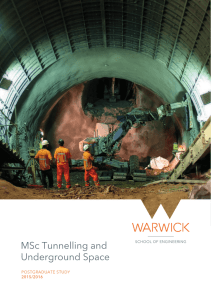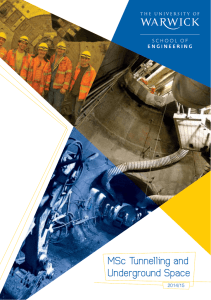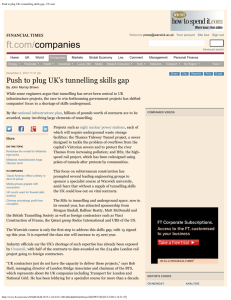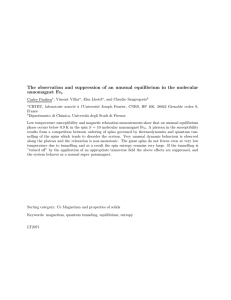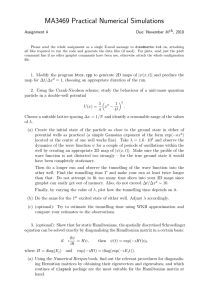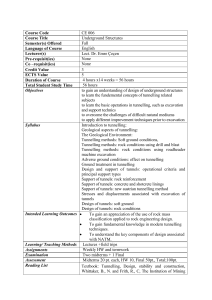The Warwick MSc - 3 Years In Director of the Tunnelling and
advertisement
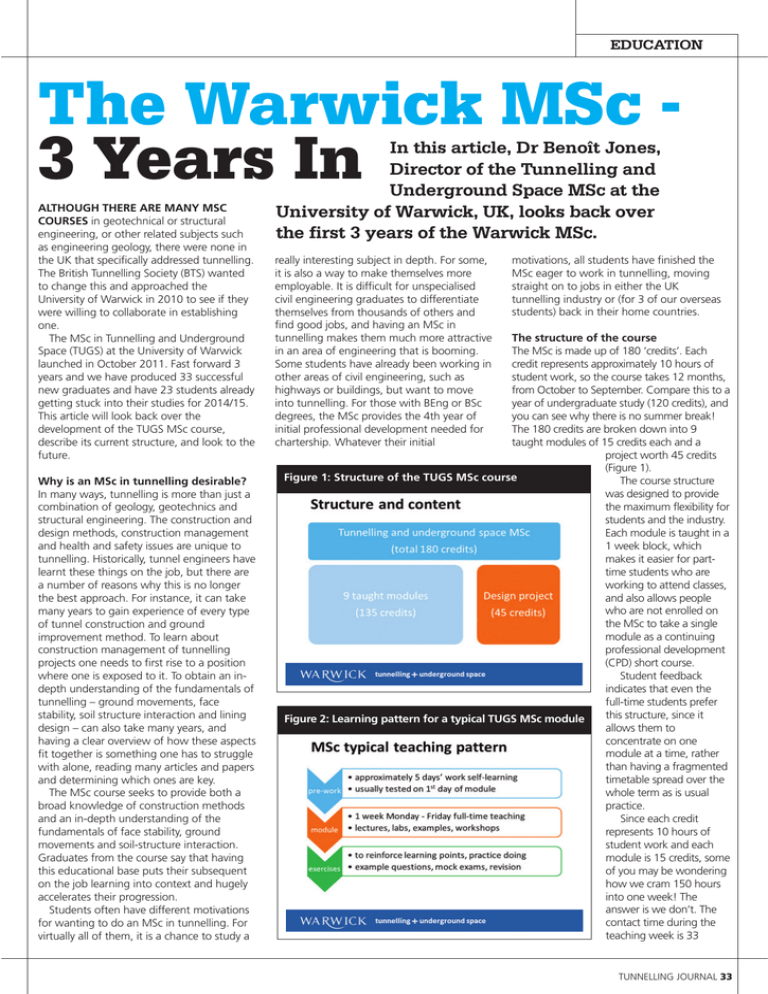
EDUCATION The Warwick MSc 3 Years In ALTHOUGH THERE ARE MANY MSC COURSES in geotechnical or structural engineering, or other related subjects such as engineering geology, there were none in the UK that specifically addressed tunnelling. The British Tunnelling Society (BTS) wanted to change this and approached the University of Warwick in 2010 to see if they were willing to collaborate in establishing one. The MSc in Tunnelling and Underground Space (TUGS) at the University of Warwick launched in October 2011. Fast forward 3 years and we have produced 33 successful new graduates and have 23 students already getting stuck into their studies for 2014/15. This article will look back over the development of the TUGS MSc course, describe its current structure, and look to the future. Why is an MSc in tunnelling desirable? In many ways, tunnelling is more than just a combination of geology, geotechnics and structural engineering. The construction and design methods, construction management and health and safety issues are unique to tunnelling. Historically, tunnel engineers have learnt these things on the job, but there are a number of reasons why this is no longer the best approach. For instance, it can take many years to gain experience of every type of tunnel construction and ground improvement method. To learn about construction management of tunnelling projects one needs to first rise to a position where one is exposed to it. To obtain an indepth understanding of the fundamentals of tunnelling – ground movements, face stability, soil structure interaction and lining design – can also take many years, and having a clear overview of how these aspects fit together is something one has to struggle with alone, reading many articles and papers and determining which ones are key. The MSc course seeks to provide both a broad knowledge of construction methods and an in-depth understanding of the fundamentals of face stability, ground movements and soil-structure interaction. Graduates from the course say that having this educational base puts their subsequent on the job learning into context and hugely accelerates their progression. Students often have different motivations for wanting to do an MSc in tunnelling. For virtually all of them, it is a chance to study a In this article, Dr Benoît Jones, Director of the Tunnelling and Underground Space MSc at the University of Warwick, UK, looks back over the first 3 years of the Warwick MSc. really interesting subject in depth. For some, it is also a way to make themselves more employable. It is difficult for unspecialised civil engineering graduates to differentiate themselves from thousands of others and find good jobs, and having an MSc in tunnelling makes them much more attractive in an area of engineering that is booming. Some students have already been working in other areas of civil engineering, such as highways or buildings, but want to move into tunnelling. For those with BEng or BSc degrees, the MSc provides the 4th year of initial professional development needed for chartership. Whatever their initial motivations, all students have finished the MSc eager to work in tunnelling, moving straight on to jobs in either the UK tunnelling industry or (for 3 of our overseas students) back in their home countries. The structure of the course The MSc is made up of 180 ‘credits’. Each credit represents approximately 10 hours of student work, so the course takes 12 months, from October to September. Compare this to a year of undergraduate study (120 credits), and you can see why there is no summer break! The 180 credits are broken down into 9 taught modules of 15 credits each and a project worth 45 credits (Figure 1). Figure 1: Structure of the TUGS MSc course The course structure was designed to provide the maximum flexibility for students and the industry. Each module is taught in a 1 week block, which makes it easier for parttime students who are working to attend classes, and also allows people who are not enrolled on the MSc to take a single module as a continuing professional development (CPD) short course. Student feedback indicates that even the full-time students prefer this structure, since it Figure 2: Learning pattern for a typical TUGS MSc module allows them to concentrate on one module at a time, rather than having a fragmented timetable spread over the whole term as is usual practice. Since each credit represents 10 hours of student work and each module is 15 credits, some of you may be wondering how we cram 150 hours into one week! The answer is we don’t. The contact time during the teaching week is 33 TUNNELLING JOURNAL 33 EDUCATION hours. Students undertake approximately 30 hours of ‘pre-work’ to prepare them to make maximum use of the taught content, and then to develop and consolidate the new material they are given example problems, assignments and further reading after the teaching week (Figure 2). The 9 taught modules, all 15 credits each, are listed in Table 1. All the modules except Professional Skills may be taken as a short course. All the modules, except Finite Element Methods for Tunnelling and Professional Skills, which are assignmentbased, are mainly assessed by an exam. The modules that are taught before Christmas have exams in January and the ones after throughout the course if they wish – allowing for some very interesting research possibilities and synergies with employers. Bursaries and funding All students nowadays have to pay tuition fees. The MSc fees are currently lower than the undergraduate fees (despite the course being 50% longer), which is great, but the downside is that MSc students are not eligible for student loans. Unfortunately, despite lobbying by the BTS and Ground Forum, the Government appear unwilling to extend the student loan scheme to taught postgraduate courses. Finding funding can be a barrier to many so Table 1: Module titles and dates Dates Module 20th-24th October 2014 th th Underground Construction Methods (part 1) 10 -14 November 2014 Geological Investigation & Ground Characterisation 24th-28th November 2014 Underground Construction Methods (part 2) 1st – 5tth December 2014 Professional Skills 9th-13th February 2015 Health, Safety and Environmental Considerations 23th-27th February 2015 Tunnel Design 16th-20th March 2015 Finite Element Methods for Tunnelling rd th 23 -27 March 2015 Construction Management 13th-17th April 2015 Rock Mechanics attend modules and exams, and providing help and advice during their project. Part-time students need approximately 6-7 weeks per year away from work to do the MSc, for 2 years. This approach seems to be more popular amongst consultants, and we have had 4 students from URS and 2 from CH2M Hill, amongst others. This year we also have part-time students from a client organisation, Network Rail, and a contractor, Dragados-Sisk JV. Obviously we are very keen for the industry to offer many more bursaries, because a lot of talented students simply do not have the upfront cash required to single-handedly equip themselves to help meet the long-term systemic shortage of skilled tunnel engineers. If all the work in the Government’s Infrastructure Pipeline goes ahead, this shortage will continue in the UK for the next 20 years at least with growth in tunnelling worldwide making it ever more untenable and irresponsible to rely on importing skills from abroad. The future is bright, but only if we have the capacity to meet it. BTS and industry support The BTS was instrumental in setting up the course, and the BTS Education Committee acts as a steering board, meeting a couple of times a year to review the curriculum and provide assistance wherever possible. In addition, each module has a ‘BTS Champion’, who helps define the syllabus (Table 2). Across the whole MSc, approximately 20% of the lectures are given by guest lecturers from the BTS, and the BTS Champions use their contacts to help find the right people. The guest lecturers add a lot of value to the course in the form of specialist knowledge and case studies. Their input is hugely valued by the BTS and the industry are rallying round to Christmas have exams in May. offer bursaries. Each year the BTS provides one After the May exams, full-time students do £12,000 bursary, Balfour Beatty provides one a 3 month design project, in groups of 3 or 4. or two £15,000 bursaries and Morgan Sindall They are given a tunnel alignment, a provides five £15,000 bursaries. As well as specification, some background information investing in the future of the industry, Morgan on constraints, and site investigation data, and Sindall and Balfour Beatty also see it as a great for each 4 week phase they are asked to way of recruiting top quality graduates, and produce: Phase 1: A Geotechnical Interpretative Report, a Geological Table 2: BTS mobile champions Long Section drawing and a Feasibility Study. Module BTS Champion Phase 2: A Design Statement, Underground Construction Methods (part 1 & 2) Colin Eddie, Morgan Sindall Underground Professional Services detailed design calculations for major elements, settlement Geological Investigation & Ground Characterisation Bob Allen, London Bridge Associates predictions, outline design of any Professional Skills Ross Dimmock, Normet settlement mitigation or ground Health, Safety and Environmental Considerations Donald Lamont, Hyperbaric & Tunnel Safety improvement measures and a Cost Tunnel Design Mike Francis, Mott MacDonald Estimate. Phase 3: A Construction Finite Element Methods for Tunnelling None at present Methodology Report, a Risk Construction Management Bob Ibell, London Bridge Associates Register, then a Method Rock Mechanics Sotiris Psomas, Morgan Sindall Underground Professional Services Statement, Risk Assessment and Inspection and Test Plan for each of Project Mark Leggett, Mott MacDonald the major elements and any Value Engineering Proposals. the students. All of them give their time freely giving them a tunnelling-specific education As well as written reports for each phase, each year and I’d like to take this opportunity before they start work. They even tell me that the groups also have to present their work to thank them all for their time and effort. The it is cost-effective compared to the costs of orally at the end of Phase 1 and Phase 3. The infographic (Figure 3) shows a ‘bubble recruiting and training graduates! final project presentations are attended by BTS diagram’, which illustrates the commitment of Many part-time students also receive a lot of committee members, who enjoy asking them guest lecturers and their companies in rather a support from their employers while on the lots of difficult questions. neat way. The area of each circle is course. This can take the form of paying Part-time students undertake an individual proportional to the number of hours of tuition fees, allowing them extra time off to research project, which they can work on 34 TUNNELLING JOURNAL EDUCATION teaching each has contributed in 2013/14, and the colours correspond to different companies. Donald Lamont’s circle wouldn’t fit on the page! The BTS provides an annual £500 prize for the best student, and the Terry Crabb Memorial Trust provides an annual £500 prize for the best project. It is important that the students get as much exposure to real live tunnels as possible, and we have been fortunate to be able to organise at least 3 site visits each year. In particular I’d like to single out John Corcoran, Tunnel Manager at the Lee Tunnel project, who has welcomed us to his site 3 times now in consecutive years. It’s a lot of work for a site to manage these visits, but the students really appreciate it and it really motivates them. This year we decided to throw them in at the deep Committee on Education and Training (ITACET). There are currently only 3 other endorsed tunnelling masters courses in the world. Hopefully in the future more will join us! Student stories Peter Coppenhall Peter Coppenhall studied the MSc in 2011/12 and passed with distinction. He was sponsored by Morgan Sindall UnPS and is currently working for them at Liverpool Street C510. He is an active member of the BTS Young Members. “The MSc at Warwick is very insightful and has really helped kick-start my career. The course has provided me with a firm knowledge base of tunnelling, whilst giving me an insight in to current practice within the industry. It has taught me a holistic approach for Figure 3: Guest lecturers (areas of circles are proportional working on tunnelling to number of hours contributed in 2013/14) projects, from looking in to construction management right down to details of how to actually construct a tunnel and the considerations required. I decided to go on the course because I wanted to enter an exciting and thriving industry and for me this was the best way to do it. I am currently working on the Crossrail project helping to co-ordinate the construction of SCL tunnels. The links to industry was one of, if not the best, aspect of the course as it end and on their second day at the university we took them to Liverpool Street Crossrail Station (thanks to Peter Coppenhall and others at BBMV for organising it). The future of the MSc The boom in tunnelling in the UK and worldwide means that there’ll never be a better time to run an MSc in Tunnelling and Underground Space. With student numbers up to 23, and extra income from short courses, the course is now financially sustainable for the university and if there continues to be growth in demand, the opportunities for study could be widened by adding more flexible options, such as evening classes in London or part-time study over more than 2 years. Higher student numbers will also result in the need for more staff to teach tunnelling at Warwick, which will bring in even more flexibility and expertise while making the course more sustainable in the medium to long-term. As well as being accredited by the Institution of Civil Engineers, the course is endorsed by the International Tunnelling Association has been really beneficial not only learning from the best in the industry but also forging professional relationships with them and the students around you who are now all working in the same industry.” Shanil Modeshia of URS on site Shanil Modeshia Shanil studied the MSc part-time from 2011 to 2013 and passed with distinction. He was supported by URS during his studies and continues to work for them in their Birmingham office. “The Tunnelling and Underground Space MSc at Warwick University was a great opportunity to expand my knowledge about tunnelling having been in the industry for 3 years after gaining my undergraduate degree in Civil Engineering. The course provided both technical and commercial aspects of tunnelling as well as developing professional skills through public engagement Peter Coppenhall representing the BTS and exercises and presentations. These are BTSYM at the Big Bang Fair all crucial skills required to become a professional engineer. Other reasons why I chose this MSc was the heavy involvement from the BTS and industry experts as well as giving me the opportunity to fulfil my ICE educational requirements. Being a part-time student proved to work well as it allowed me to put what I had learnt into context with projects I was working on. The course was setup well for a part time student as the modules were contained within one week blocks making attendance easier. The MSc has helped in giving me a diverse range of skills through the taught modules and self-study and research undertaken for the dissertation. These skills have and are being used in the work place today from the basic tunnelling theories learnt through to 3D Finite Element Modelling.” TUNNELLING JOURNAL 35
